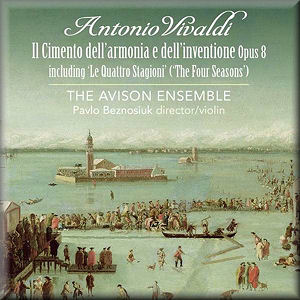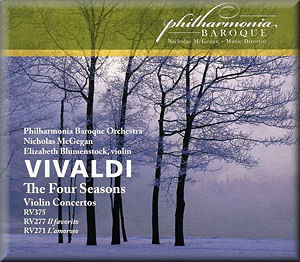 |
 |
|


alternatively
CD: MDT
AmazonUK
AmazonUS
|
Antonio VIVALDI (1678 -
1741)
Il Cimento dell'armonia e dell'inventione Opus
8
CD 1
Concerto in E, op. 8,1 'La Primavera' (RV
269) [10:21]
Concerto in g minor, op. 8,2 'L'Estate'
(RV 315) [10:25]
Concerto in F, op. 8,3 'L'Autunno'
(RV 293) [10:17]
Concerto in f minor, op. 8,4 'L'Inverno'
(RV 297) [8:25]
Concerto in E flat, op. 8,5 'La Tempesta di Mare'
(RV 253) [9:13]
Concerto in C, op. 8,6 'Il Piacere' (RV 180)
[9:09]
CD 2
Concerto in d minor, op. 8,7 (RV 242) [8:12]
Concerto in g minor, op. 8,8 (RV 332) [9:47]
Concerto in d minor, op. 8,9 (RV 454) [8:06]
Concerto in Bes, op. 8,10 'La Caccia' (RV
362) [8:34]
Concerto in D, op. 8,11 (RV 210) [12:27]
Concerto in C, op. 8,12 (RV 449) [9:04]
 The Avison Ensemble/Pavlo Beznosiuk (violin)
The Avison Ensemble/Pavlo Beznosiuk (violin)
rec. 29 November - 5 December, St George's Chesterton, Cambridge,
UK. DDD
 LINN RECORDS
LINN RECORDS  CKD
365 [57:54 + 56:16] CKD
365 [57:54 + 56:16]
|
|


alternatively
CD: MDT
AmazonUK
AmazonUS
|
Antonio VIVALDI (1678 -
1741) The Four Seasons - Violin Concertos
Concerto in E, op. 8,1 'La Primavera' (RV
269) [9:29]
Concerto in g minor, op. 8,2 'L'Estate'
(RV 315) [9:53]
Concerto in F, op. 8,3 'L'Autunno'
(RV 293) [10:10]
Concerto in f minor, op. 8,4 'L'Inverno'
(RV 297) [8:15]
Concerto in B flat (RV 375) [13:55]
Concerto in e minor 'Il favorito' (RV 277)
[13:33]
Concerto in E 'L'amoroso' (RV 271)
[10:11]
 Elizabeth Blumenstock (violin)
Elizabeth Blumenstock (violin)
Philharmonia Baroque Orchestra/Nicholas McGegan
rec. 9 - 11 December 2010, Skywalker Sound, Nicasio, CA, USA. DDD
 PHILHARMONIA BAROQUE PRODUCTIONS PBP-03 [75:30]
PHILHARMONIA BAROQUE PRODUCTIONS PBP-03 [75:30]
|
|
|
Comparison: Montanari/Dantone (Arts)
Many of Vivaldi's concertos bear titles. They are sometimes
referred to as 'programme music', but that is
mostly incorrect. There is a difference between 'programme
music' and 'descriptive music'. The former
has a story line or illustrates a sequence of events, whereas
the latter only depicts a phenomenon or an emotion. To make
things even more complicated: many pieces of the baroque era
are descriptive, even though they bear no titles at all. Most
of Vivaldi's concertos with titles belong to the category
of 'descriptive music', like la notte
(the night) or la tempesta di mare (the storm at sea).
The Concerto in E 'L'amoroso'
(RV 271) which is included in the Philharmonia Baroque Orchestra's
disc is an example of a concerto which refers to an emotion.
The Four Seasons are without any doubt the most famous
of all Vivaldi's concertos. They were already famous
in Vivaldi's own time, immediately after being printed
in 1725 as part of the twelve concertos Op. 8. There can be
no doubt about their programmatic character, because Vivaldi
added four sonnets describing the features of the various seasons.
In order to leave no doubt about his intentions he added precise
indications about the meaning of various effects in several
of the concerto's parts.
It is notable that neither the sonnets nor these indications
were part of these concertos at the onset. The Op. 8 was dedicated
to the Bohemian count Morzin who had honoured Vivaldi with the
title maestro di musica in Italia. The composer had
sent the Four Seasons to the count some time before
1725 or probably performed them in his presence. In his preface
he writes: "I beg Your Highness not to be astonished at
finding among these few feeble concertos The Four Seasons,
which met with Your Highness's indulgent approval so
many years ago; believe me, I found them worthy of being printed
- although in every respect they are the same pieces - because
on this occasion I have added not only the sonnets but also
precise explanations on all the things that are depicted here."
It seems that he didn't want to create any misunderstandings
about the meaning of these concertos now that they could be
played by others than himself.
There are many recordings of these four concertos in the catalogue.
They are mostly performed independently, without the other eight
concertos of the Op. 8 set. Those who only want to have the
Four Seasons will probably not purchase a recording
of a whole set. That is a shame as the other concertos are not
in any way inferior to these four. Anyway, that makes it less
useful to compare the recording of The Avison Ensemble with
other recent recordings of the Four Seasons. I have
therefore chosen the recording of the complete set by Stefano
Montanari and the Accademia Bizantina, directed by Ottavio Dantone,
released with the concertos Opus 3 by Arts.
I was generally enthusiastic about their performances, even
though I find the size of the ensemble, including seven violins,
debatable.
In comparison I have strong reservations about both recordings
reviewed here. The Avison Ensemble and the Philharmonia Baroque
Orchestra (PBO) are even larger than the Accademia Bizantina,
with 9 and 11 violins respectively. It is not easy to decide
what the common size of instrumental ensembles in Vivaldi's
time was. The orchestra of the Ospedale della Pietą allowed
larger scorings than one instrument per part. That was probably
the exception. What is more important is the relationship between
the solo instrument and the tutti. Whatever the size of the
instrumental body, the soloist is always primus inter pares;
solo concertos of the baroque era are ensemble pieces, not -
as in the romantic era - for a soloist and an orchestra. In
PBO's recording Elizabeth Blumenstock is too much in
front of the orchestra and seems even not to be part of it.
In comparison, Pavlo Beznosiuk is more integrated in the ensemble.
What these two recordings have in common is a lack of transparency.
That is due not only to the size of the orchestras: the performance
of the Accademia Bizantina is clearly better in this respect.
There is little to choose between the performances of Pavlo
Beznosiuk and Elizabeth Blumenstock. Both are fine violinists
and have no technical problems in realizing the demanding solo
part. Some effects come off better in one performance, others
in the other. Let me just mention a couple of things. Both interpretations
of the first concerto are too tame. Blumenstock depicts the
bird singing in the first movement better than Beznosiuk. Not
much is made in either recording of the repeated notes in the
second movement which are a depiction of the barking of the
shepherd's dog. In the last movement both violinists
fail to illustrate the dancing of nymphs and shepherds.
The second concerto is rather well done by both, but Beznosiuk
makes the most of the imitation of cuckoo, turtledove and goldfinch
in the first movement. The cuckoo is virtually inaudible in
Blumenstock's performance. The threatening atmosphere
in the second movement is also slightly better with Beznosiuk,
partly due to his slower tempo.
The first movement of the third concerto describes the dance
and song of the peasants. It is notable that Beznosiuk plays
it largely legato. It reminds me of the sound of the musette,
often associated with the countryside. Was that the thought
behind this decision? Ms Blumenstock plays it more like dance
music, but she makes a bit too heavy weather of it. The last
movement is a hunting scene, and at the end the prey dies. I
particularly like the way the Philharmonia Baroque Orchestra
plays the last phrase piano: the music dies with the prey.
The last concerto is the least satisfying in both performances.
The first movement lacks subtlety. There is more to it than
both suggest as Stefano Montanari's recording shows.
The falling raindrops come off better in Beznosiuk's
interpretation than in Ms Blumenstock's. The latter movement
is again most differentiated with Montanari. In the first movement
of this concerto the distance between the solo violin of Elizabeth
Blumenstock and the Philharmonia Baroque Orchestra is all too
obvious and here it is more of a problem than elsewhere.
There is no one way to perform these concertos. Nowadays we
are used to hearing them in rather theatrical recordings by
Italian ensembles. Sometimes they tend to exaggerate, as I recently
observed while listening to an almost caricature-like performance
by Forma Antiqva (Winter & Winter, 2012). Beznosiuk and
Blumenstock are more or less at the other side of the spectrum,
and reflect the more restrained Anglo-Saxon approach. Despite
the size of the ensemble Montanari and Dantone seem to have
found an approach which is just right, being theatrical and
evocative, but still observing the baroque ideal of balance
and good taste.
The Avison Ensemble also offers the other eight concertos from
Op. 8. Here again I prefer the Accademia Bizantina, especially
because of better articulation, a more relaxed way of playing
and a more differentiated treatment of the notes and of dynamics.
For the concertos 9 and 12 Vivaldi has indicated the oboe as
the alternative for the violin. Dantone has given them to the
oboe, in Beznosiuk's performance they are played by the
violin. It would have been nice to have them in both versions
- there was enough space left on both discs.
The PBO's recording includes three other violin concertos.
The performances are rather good, but the size of the ensemble
and the position of the solo violin in the ensemble is problematic
once again. The recording of the concertos RV 271 and 277 by
Enrico Casazza and La Magnificą Comunita is much more an ensemble
effort with the violinist acting as part of the body of strings
(review).
To sum up: both recordings have nice things to offer, but they
fall short in fully exploring the character of Vivaldi's
concertos.
Johan van Veen
http://www.musica-dei-donum.org
https://twitter.com/johanvanveen
|
|

